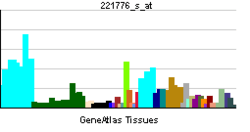BRD7
Bromodomain-containing protein 7 is a protein that in humans is encoded by the BRD7 gene.[1][2][3]
Interactions
BRD7 has been shown to interact with IRF2[4] and HNRPUL1.[5]
References
- ↑ Cuppen E, van Ham M, Pepers B, Wieringa B, Hendriks W (November 1999). "Identification and molecular characterization of BP75, a novel bromodomain-containing protein". FEBS Lett 459 (3): 291–298. doi:10.1016/S0014-5793(99)01191-6. PMID 10526152.
- ↑ Kaeser MD, Aslanian A, Dong MQ, Yates JR 3rd, Emerson BM (November 2008). "BRD7, a novel PBAF-specific SWI/SNF subunit, is required for target gene activation and repression in embryonic stem cells". J Biol Chem 283 (47): 32254–32263. doi:10.1074/jbc.M806061200. PMC 2583284. PMID 18809673.
- ↑ "Entrez Gene: BRD7 bromodomain containing 7".
- ↑ Staal, A; Enserink J M; Stein J L; Stein G S; van Wijnen A J (November 2000). "Molecular characterization of celtix-1, a bromodomain protein interacting with the transcription factor interferon regulatory factor 2". J. Cell. Physiol. (UNITED STATES) 185 (2): 269–279. doi:10.1002/1097-4652(200011)185:2<269::AID-JCP12>3.0.CO;2-L. ISSN 0021-9541. PMID 11025449.
- ↑ Kzhyshkowska, Julia; Rusch Andre; Wolf Hans; Dobner Thomas (April 2003). "Regulation of transcription by the heterogeneous nuclear ribonucleoprotein E1B-AP5 is mediated by complex formation with the novel bromodomain-containing protein BRD7". Biochem. J. (England) 371 (Pt 2): 385–93. doi:10.1042/BJ20021281. ISSN 0264-6021. PMC 1223277. PMID 12489984.
Further reading
- Staal A; Enserink JM; Stein JL et al. (2000). "Molecular characterization of celtix-1, a bromodomain protein interacting with the transcription factor interferon regulatory factor 2". J. Cell. Physiol. 185 (2): 269–279. doi:10.1002/1097-4652(200011)185:2<269::AID-JCP12>3.0.CO;2-L. PMID 11025449.
- Strausberg RL; Feingold EA; Grouse LH et al. (2003). "Generation and initial analysis of more than 15,000 full-length human and mouse cDNA sequences". Proc. Natl. Acad. Sci. U.S.A. 99 (26): 16899–16903. doi:10.1073/pnas.242603899. PMC 139241. PMID 12477932.
- Kzhyshkowska J, Rusch A, Wolf H, Dobner T (2003). "Regulation of transcription by the heterogeneous nuclear ribonucleoprotein E1B-AP5 is mediated by complex formation with the novel bromodomain-containing protein BRD7". Biochem. J. 371 (Pt 2): 385–93. doi:10.1042/BJ20021281. PMC 1223277. PMID 12489984.
- Zhou M; Peng C; Nie XM et al. (2003). "[Expression of BRD7-interacting proteins,BRD2 and BRD3, in nasopharyngeal carcinoma tissues]". Ai Zheng 22 (2): 123–7. PMID 12600283.
- Tomarev SI; Wistow G; Raymond V et al. (2003). "Gene expression profile of the human trabecular meshwork: NEIBank sequence tag analysis". Invest. Ophthalmol. Vis. Sci. 44 (6): 2588–2596. doi:10.1167/iovs.02-1099. PMID 12766061.
- Zhang XM; Wang XY; Sheng SR et al. (2003). "Expression of tumor related genes NGX6, NAG-7, BRD7 in gastric and colorectal cancer". World J. Gastroenterol. 9 (8): 1729–33. PMID 12918109.
- Kim S, Lee J, Park J, Chung J (2003). "BP75, bromodomain-containing M(r) 75,000 protein, binds dishevelled-1 and enhances Wnt signaling by inactivating glycogen synthase kinase-3 beta". Cancer Res. 63 (16): 4792–5. PMID 12941796.
- Ota T; Suzuki Y; Nishikawa T et al. (2004). "Complete sequencing and characterization of 21,243 full-length human cDNAs". Nat. Genet. 36 (1): 40–45. doi:10.1038/ng1285. PMID 14702039.
- Zhou J; Ma J; Zhang BC et al. (2004). "BRD7, a novel bromodomain gene, inhibits G1-S progression by transcriptionally regulating some important molecules involved in ras/MEK/ERK and Rb/E2F pathways". J. Cell. Physiol. 200 (1): 89–98. doi:10.1002/jcp.20013. PMID 15137061.
- Goehler H; Lalowski M; Stelzl U et al. (2004). "A protein interaction network links GIT1, an enhancer of huntingtin aggregation, to Huntington's disease". Mol. Cell 15 (6): 853–865. doi:10.1016/j.molcel.2004.09.016. PMID 15383276.
- Gerhard DS; Wagner L; Feingold EA et al. (2004). "The status, quality, and expansion of the NIH full-length cDNA project: the Mammalian Gene Collection (MGC)". Genome Res. 14 (10B): 2121–2127. doi:10.1101/gr.2596504. PMC 528928. PMID 15489334.
- Peng C; Zhou J; Liu HY et al. (2006). "The transcriptional regulation role of BRD7 by binding to acetylated histone through bromodomain". J. Cell. Biochem. 97 (4): 882–892. doi:10.1002/jcb.20645. PMID 16265664.
- Zhou M; Liu H; Xu X et al. (2006). "Identification of nuclear localization signal that governs nuclear import of BRD7 and its essential roles in inhibiting cell cycle progression". J. Cell. Biochem. 98 (4): 920–930. doi:10.1002/jcb.20788. PMID 16475162.
- Zhou M; Xu XJ; Zhou HD et al. (2007). "BRD2 is one of BRD7-interacting proteins and its over-expression could initiate apoptosis". Mol. Cell. Biochem. 292 (1–2): 205–212. doi:10.1007/s11010-006-9233-4. PMID 16786191.
- Liu H; Peng C; Zhou M et al. (2006). "Cloning and characterization of the BRD7 gene promoter". DNA Cell Biol. 25 (6): 346–358. doi:10.1089/dna.2006.25.346. PMID 16792505.
- Olsen JV; Blagoev B; Gnad F et al. (2006). "Global, in vivo, and site-specific phosphorylation dynamics in signaling networks". Cell 127 (3): 635–648. doi:10.1016/j.cell.2006.09.026. PMID 17081983.
